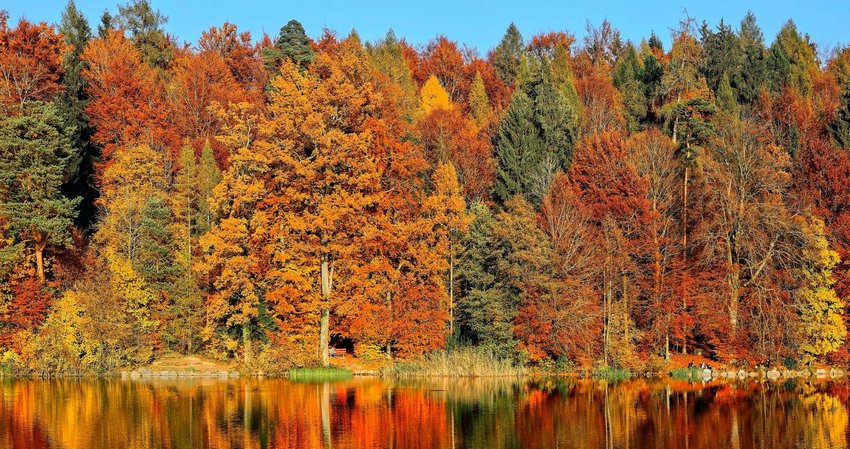Are you ready to turn those calendar pages to fall? Or is it autumn? "Fall" is an Americanism of "autumn," but whichever word you use, it’s still a season to inspire cozy, colorful observations. Fall is the season for hayrides, flannel shirts, and pumpkin EVERYTHING. The next time you claim autumn as your favorite season, you can explain the origins of these favorite fall words.
Pumpkin Spice
You can get it as a coffee, a candle, even an Oreo flavor. But what's so special about pumpkin spice? The name might trick you — traditionally, it’s not pumpkin flavored at all. Pumpkin spice refers to a blend of cinnamon, with notes of nutmeg, ginger, cloves, and allspice. Pumpkin spice has been referred to in cookbooks since the 1890s, but we can thank Starbucks for the ubiquitous presence of this fall flavor. The Starbucks Pumpkin Spice Latte was introduced in 2003 and quickly became one of its most popular seasonal flavors. In 2015, the pumpkin was brought to the forefront of the PSL, and a small amount of pumpkin puree was added to the spice recipe.
Hygge
Repeat after me: HOO-gah. This Danish word might not be easy for American speakers to pronounce, but the trend has taken over your fall and winter. "Hygge" is hard to define exactly, but the general concept is taking comfort in simple pleasures. Sitting on a metal bus bench with wet socks and rain dripping down your collar? NOT "hygge." Snuggling on the couch under a hand-knit blanket with a mug full of cocoa and candles flickering in the corners? Now that's "hygge."
"Hygge" is used as both a noun and an adjective in Danish, but the term was adopted into English as a lifestyle trend around 2016. Since then, you’ve likely seen articles written about it, and it was even included in a song in the Broadway adaptation of “Frozen.” While some trends disappear as quickly as they come, "hygge" is one trend we’re happy to hold onto for many seasons to come.
Bonus Summer
In a world where we know better than to use a term such as "Indian summer," we still want to rejoice when we get the pleasure of a summer-like day in the fall. You know it as that magical time in October or November when the sun is shining and you can (briefly) shed your coat. Consider calling these days a "bonus summer," or take a hint from the Germans and call it an "old wives' summer." In Turkey, this is the time of year for making pastirma, so, please, enjoy your days of "pastrami summer."
Fall Equinox
The equinox is an astronomical event that occurs twice a year. If you’re in the Northern Hemisphere, you can accurately refer to the second occurrence as the fall or autumnal equinox. However, in the Southern Hemisphere, sometimes this second equinox is referred to as the vernal (spring) equinox. It might just be better to call them by their months — the March and September equinoxes.
Equinox refers to the exact moment when the center of the sun is directly above the equator. On the day of the equinox, daytime and nighttime are of approximately equal duration, all over the world. The sun rises at about 06:00 and sets at about 18:00 (local time) everywhere in the world, except the poles. The fall equinox also marks the beginning of autumn on your calendar in the Northern Hemisphere. In 2020, the September equinox occurs at 13:30 Greenwich Mean Time on September 23.
Harvest Moon
Here’s another astronomical event: The Harvest Moon is the full moon that occurs closest to the autumnal equinox and is characterized by its orange color. It can occur before or after the equinox. The first recorded use of this name was in 1706, and it probably came from farmers taking advantage of the large full moon to complete their harvests. The Harvest Moon now marks celebrations in many cultures. The Moon Festival is celebrated in China, Vietnam, Taiwan, and Hong Kong. In the United States, we still honor the harvest time with fall festivals, farmers' markets, and craft fairs.
Deciduous
If you love fall, you probably treasure long drives through avenues filled with red, orange, and yellow falling leaves. The beauty of this color extravaganza is thanks to deciduous trees. The word "deciduous" refers to trees with leaves that fall off or shed seasonally. This yearly occurrence might be a simple fact of nature, but it brings an enchanting magic to the fall landscape. In New England, there’s a special category of tourists called “leaf peepers” who make an annual pilgrimage to view the intense colors of a Northeastern fall. If you’d like to plant your own deciduous tree and improve your fall color palette, try one of these trees: Sugar Maple, Black Tupelo, Sourwood, or Sassafras.

